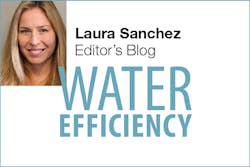Rising seas are an emerging threat to infrastructure everywhere. But a new study finds that land in some coastal areas is also sinking at a rapid rate, accelerating the need to protect pipelines, pump stations, and treatment facilities.
The geological force at work is called subsidence. According to the USGS, subsidence, or sinking earth, occurs most often when groundwater is pumped from beneath rock and soil and, as a result, these layers collapse. But it can also happen when areas developed on landfill soils compact.
In places like the San Francisco, where fill dirt was used to create a number of manmade coastal spaces, this poses a significant problem. According to a new study by Manoochehr Shirzaei and Roland Bürgmann, the simultaneous effect of sinking land and rising ocean levels could present a greater problem than scientists previously considered. According to their data, the San Francisco Airport could see half of its runways underwater by 2100.
To evaluate the severity of the issue, the researchers took synthetic aperture radar interferometric measurements and used global navigation satellite system data to show that in most areas of the San Francisco Bay, subsidence rates measure less than 2 mm/year. However, in some coastal areas produced by landfill, rates are upwards of 10 mm/year. Treasure Island, between San Francisco and Oakland, is reportedly sinking at a rate of a third of an inch a year.
“Considering sea level rise alone, models show that, on the low end, 20 square miles could be inundated by 2100. But factor in subsiding land and that estimate jumps to almost 50 square miles. The high end? 165 square miles lost,” explains a recent WIRED article. Water conveyance systems and treatment plants located in areas affected by both subsidence and sea level rise are especially at risk.
“We are only looking at a scenario where we raise the bathtub water a little bit higher and look where the water level would stand,” senior author Roland Bürgmann told Science Daily. “But what if we have a 100-year storm, or king tides, or other scenarios of peak water-level change? We are providing an average; the actual area that would be flooded by peak rainfall and runoff and storm surges is much larger.”
The team hopes that the new data will help state and local agencies protect infrastructure, plan future projects, and improve hazard maps. Is subsidence an issue in your area? What steps has your organization taken to protect infrastructure from sea level rise?

